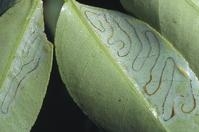Citrus Leafminer calls are up these last few weeks. This is one of those insects that loves new tissue and the fall flush usually gets it pretty badly because their populations have been hovering around all summer waiting for some new flush to come. Damage can be pretty shocking, but other than young trees which can be defoliated and killed, it is not a pest we should worry about, largely because it is difficult to control and we do not have any information that yields or quality are affected by fall infestations
Description of the Pest
Citrus leafminer is a very small, light colored moth that arrived in southern California from Mexico in 2000. Citrus leafminer has been moving northward in backyard and commercial citrus since that time and now infests citrus in southern and central California.
Adult citrus leafminers are tiny moths about 2 mm long (less than 0.12 inch) with a wingspan of about 4 mm (or about 0.25 inch). They have silvery and white iridescent forewings with brown and white markings and a distinct black spot on each wing tip. Moths are most active from dusk to early morning and spend the day resting on the undersides of leaves, but are rarely observed. Soon after emerging from the pupal case, the female emits a sex pheromone that attracts males. Females lay eggs singly on the underside of leaves. Newly emerged leaflets (flush), particularly along the midvein, are the preferred oviposition site.
Eggs hatch about 4-5 days after being laid and newly hatched larvae begin feeding immediately in shallow, meandering mines in the leaves. As a larva increases in size, the mine becomes more visible and larval excrement forms a thin, central frass trail within the mine. Larvae molt 4 times over a 1 to 3 week period. Mature larvae pupate within the mine, rolling the edge of the leaf and protecting the pupa with silk. The entire life cycle of the insect takes 2 to 7 weeks to complete, depending on temperature and weather conditions. The activities of citrus leafminer vary somewhat with location in the state because of differences in climatic conditions and flushing of citrus trees. In general, citrus leafminer is active from mid-summer through fall and early winter.
The citrus peelminer, a small moth that attacks citrus, differs from citrus leafminer because its larval stages do not leave a frass trail in the mine, and it attacks stems and fruit rather than new flush leaves. Also, the peelminer pupa has decorative balls on its cocoon whereas leafminer pupae are found in the curled edge of a leaf and lack decorative balls.
Damage
Citrus leafminer larvae feed by creating shallow tunnels, referred to as mines, in young leaves. It is most commonly found on citrus (oranges, mandarins, lemons, limes, grapefruit and other varieties) and closely related plants (kumquat and calamondin). The larvae mine the lower or upper surface of the leaves causing them to curl and look distorted. Mature citrus trees (more than 4 years old) generally tolerate leaf damage without any effect on tree growth or fruit yield. Citrus leafminer is likely to cause damage in nurseries and new plantings because the growth of young trees is retarded by leafminer infestations. However, even when infestations of citrus leafminer are heavy on young trees, trees are unlikely to die.
For more on this pest see:
http://www.ipm.ucdavis.edu/PMG/r107303211.html
Citrus Leafminer tunnels on leaves.
Attached Images:
